2021 HONDA CLARITY FUEL CELL window
[x] Cancel search: windowPage 7 of 555
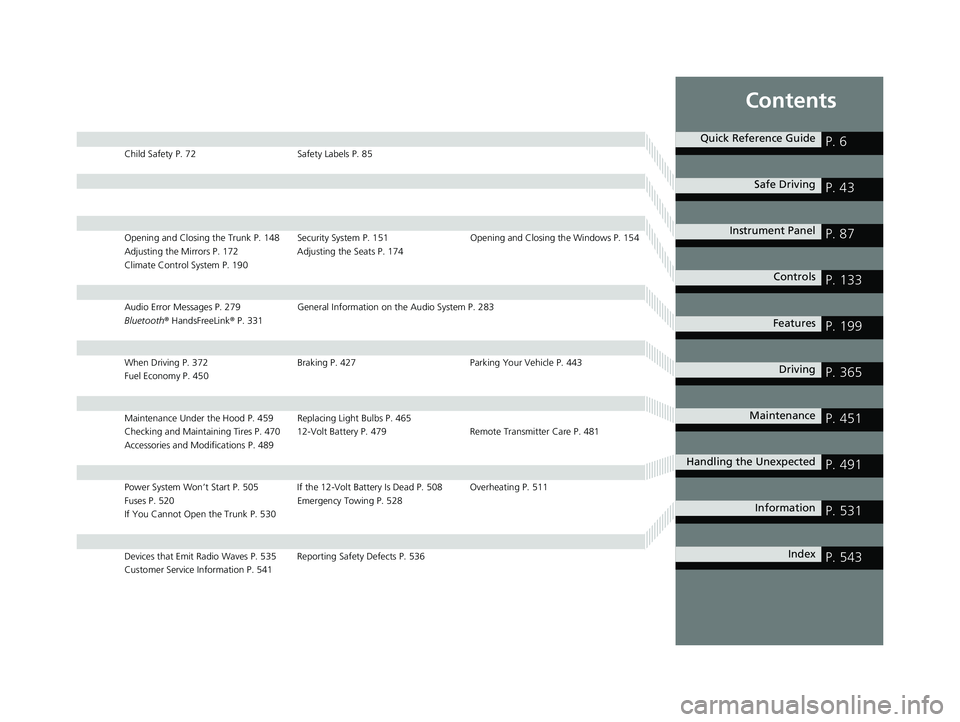
Contents
Child Safety P. 72Safety Labels P. 85
Opening and Closing the Trunk P. 148 Security System P. 151 Opening and Closing the Windows P. 154
Adjusting the Mirrors P. 172 Adjusting the Seats P. 174
Climate Control System P. 190
Audio Error Messages P. 279 General Information on the Audio System P. 283
Bluetooth ® HandsFreeLink ® P. 331
When Driving P. 372 Braking P. 427Parking Your Vehicle P. 443
Fuel Economy P. 450
Maintenance Under the Hood P. 459 Replacing Light Bulbs P. 465
Checking and Maintaining Tires P. 470 12-Volt Battery P. 479 Remote Transmitter Care P. 481
Accessories and Modifications P. 489
Power System Won’t Start P. 505 If the 12-Volt Battery Is Dead P. 508 Overheating P. 511
Fuses P. 520 Emergency Towing P. 528
If You Cannot Open the Trunk P. 530
Devices that Emit Radio Waves P. 535 Reporting Safety Defects P. 536
Customer Service Information P. 541
Quick Reference GuideP. 6
Safe DrivingP. 43
Instrument PanelP. 87
ControlsP. 133
FeaturesP. 199
DrivingP. 365
MaintenanceP. 451
Handling the UnexpectedP. 491
InformationP. 531
IndexP. 543
21 CLARITY FCV CSS-31TRT6400_02.book 5 ページ 2020年9月25日 金曜日 午後3時15分
Page 10 of 555
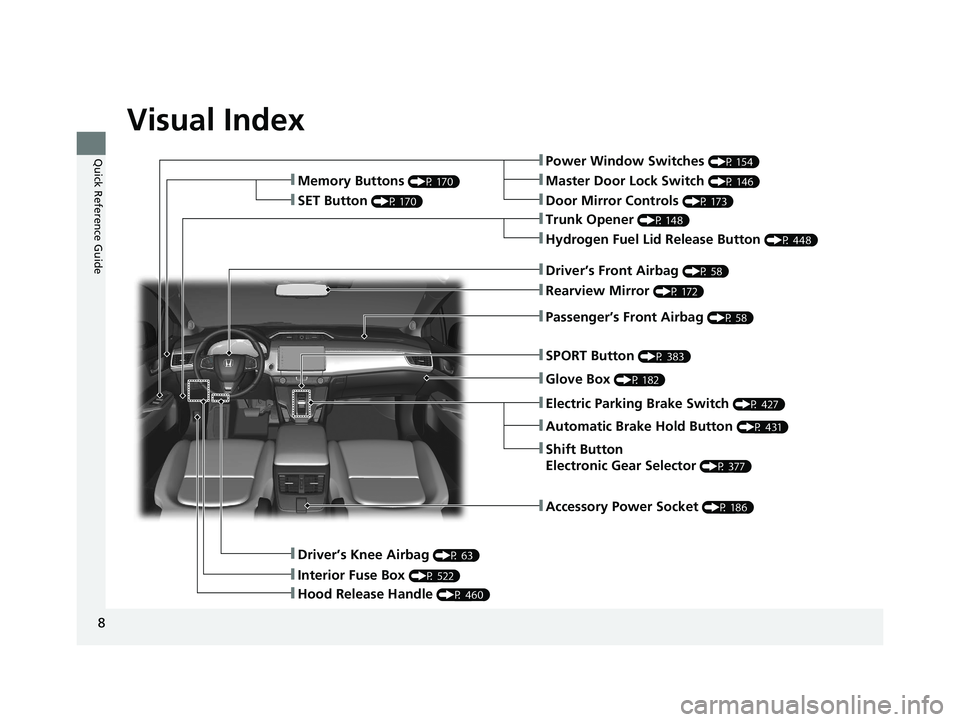
Visual Index
8
Quick Reference Guide❚Power Window Switches (P 154)
❚Trunk Opener (P 148)
❚Driver’s Knee Airbag (P 63)
❚Door Mirror Controls (P 173)
❚Master Door Lock Switch (P 146)
❚Hydrogen Fuel Lid Release Button (P 448)
❚SET Button (P 170)
❚Automatic Brake Hold Button (P 431)
❚Passenger’s Front Airbag (P 58)
❚Rearview Mirror (P 172)
❚SPORT Button (P 383)
❚Glove Box (P 182)
❚Shift Button
Electronic Gear Selector
(P 377)
❚Accessory Power Socket (P 186)
❚Hood Release Handle (P 460)
❚Memory Buttons (P 170)
❚Driver’s Front Airbag (P 58)
❚Electric Parking Brake Switch (P 427)
❚Interior Fuse Box (P 522)
21 CLARITY FCV CSS-31TRT6400_02.book 8 ページ 2020年9月25日 金曜日 午後3時15分
Page 31 of 555
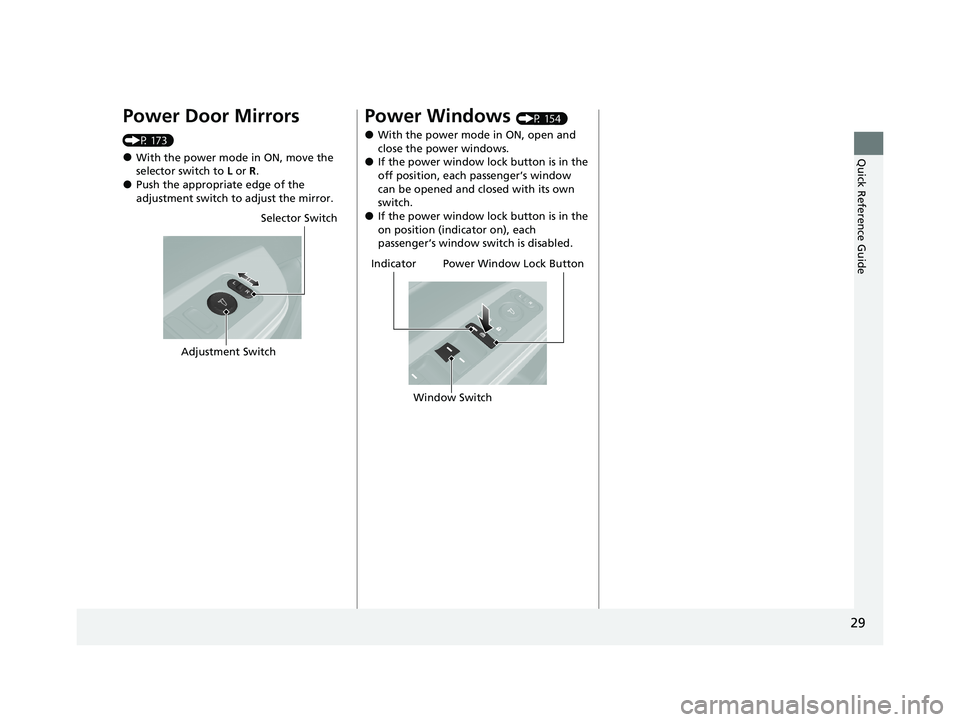
29
Quick Reference Guide
Power Door Mirrors
(P 173)
●With the power mode in ON, move the
selector switch to L or R .
●Push the appropriate edge of the
adjustment switch to adjust the mirror.
Selector Switch
Adjustment Switch
Power Windows (P 154)
●With the power mode in ON, open and
close the power windows.
●If the power window lock button is in the
off position, each passenger’s window
can be opened and closed with its own
switch.
●If the power window lock button is in the
on position (indicator on), each
passenger’s window switch is disabled.
Power Window Lock Button
Window SwitchIndicator
21 CLARITY FCV CSS-31TRT6400_02.book 29 ページ 2020年9月25日 金曜日 午後3時15分
Page 58 of 555
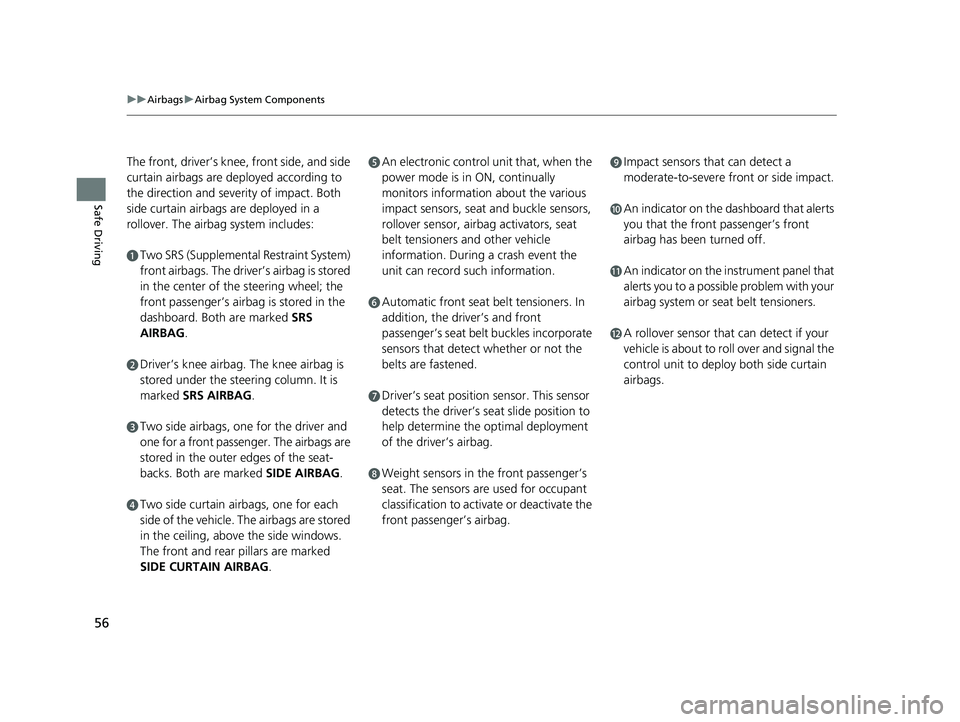
56
uuAirbags uAirbag System Components
Safe Driving
The front, driver’s knee, front side, and side
curtain airbags are deployed according to
the direction and severity of impact. Both
side curtain airbags are deployed in a
rollover. The airbag system includes:
aTwo SRS (Supplemental Restraint System)
front airbags. The driver’s airbag is stored
in the center of the steering wheel; the
front passenger’s airbag is stored in the
dashboard. Both are marked SRS
AIRBAG.
bDriver’s knee airbag. The knee airbag is
stored under the steering column. It is
marked SRS AIRBAG.
cTwo side airbags, one for the driver and
one for a front passenger. The airbags are
stored in the outer edges of the seat-
backs. Both are marked SIDE AIRBAG .
dTwo side curtain airbags, one for each
side of the vehicle. The airbags are stored
in the ceiling, above the side windows.
The front and rear pillars are marked
SIDE CURTAIN AIRBAG.
eAn electronic control unit that, when the
power mode is in ON, continually
monitors information about the various
impact sensors, seat and buckle sensors,
rollover sensor, airbag activators, seat
belt tensioners and other vehicle
information. During a crash event the
unit can record such information.
fAutomatic front seat belt tensioners. In
addition, the driver’s and front
passenger’s seat belt buckles incorporate
sensors that detect whether or not the
belts are fastened.
gDriver’s seat position sensor. This sensor
detects the driver’s seat slide position to
help determine the optimal deployment
of the driver’s airbag.
hWeight sensors in the front passenger’s
seat. The sensors are used for occupant
classification to activate or deactivate the
front passenger’s airbag.
iImpact sensors that can detect a
moderate-to-severe front or side impact.
jAn indicator on the dashboard that alerts
you that the front passenger’s front
airbag has been turned off.
kAn indicator on the instrument panel that
alerts you to a possib le problem with your
airbag system or seat belt tensioners.
lA rollover sensor that can detect if your
vehicle is about to roll over and signal the
control unit to deploy both side curtain
airbags.
21 CLARITY FCV CSS-31TRT6400_02.book 56 ページ 2020年9月25日 金曜日 午後3時15分
Page 60 of 555
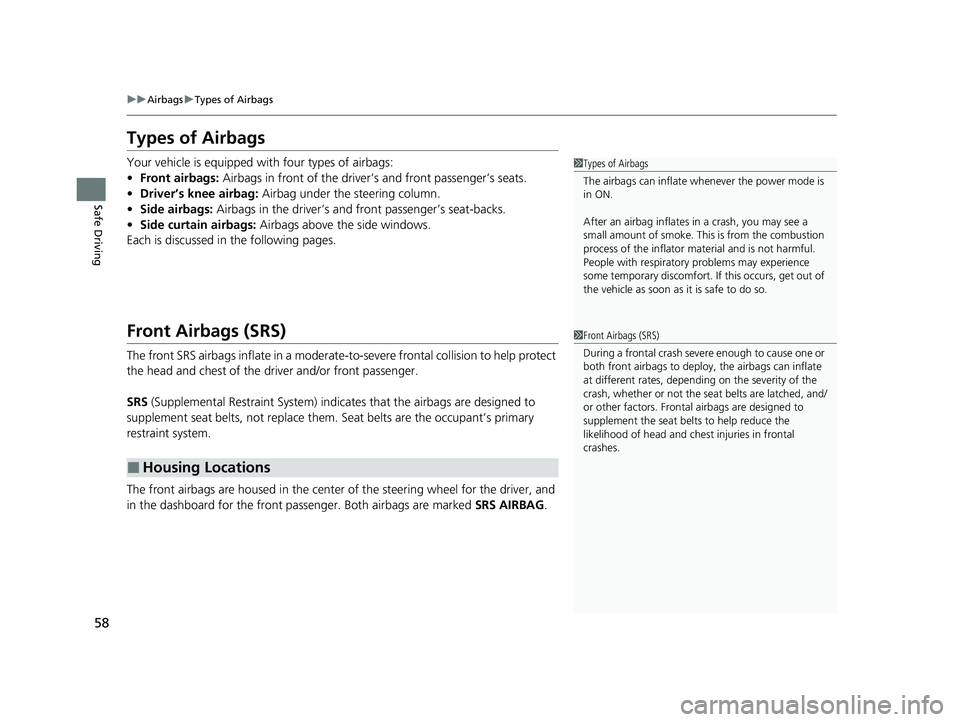
58
uuAirbags uTypes of Airbags
Safe Driving
Types of Airbags
Your vehicle is equipped with four types of airbags:
• Front airbags: Airbags in front of the driver ’s and front passenger’s seats.
• Driver’s knee airbag: Airbag under the steering column.
• Side airbags: Airbags in the driver’s and front passenger’s seat-backs.
• Side curtain airbags: Airbags above the side windows.
Each is discussed in the following pages.
Front Airbags (SRS)
The front SRS airbags inflate in a moderate-to -severe frontal collision to help protect
the head and chest of the driver and/or front passenger.
SRS (Supplemental Restraint System) indicates that the airbags are designed to
supplement seat belts, not replace them. Seat belts are the occupant’s primary
restraint system.
The front airbags are housed in the center of the steering wheel for the driver, and
in the dashboard for the front pass enger. Both airbags are marked SRS AIRBAG.
■Housing Locations
1Types of Airbags
The airbags can inflate whenever the power mode is
in ON.
After an airbag inflates in a crash, you may see a
small amount of smoke. This is from the combustion
process of the infl ator material and is not harmful.
People with respiratory pr oblems may experience
some temporary discomfort. If this occurs, get out of
the vehicle as soon as it is safe to do so.
1 Front Airbags (SRS)
During a frontal crash severe enough to cause one or
both front airbags to deploy, the airbags can inflate
at different rates, dependi ng on the severity of the
crash, whether or not the se at belts are latched, and/
or other factors. Frontal airbags are designed to
supplement the seat belts to help reduce the
likelihood of head and chest injuries in frontal
crashes.
21 CLARITY FCV CSS-31TRT6400_02.book 58 ページ 2020年9月25日 金曜日 午後3時15分
Page 69 of 555
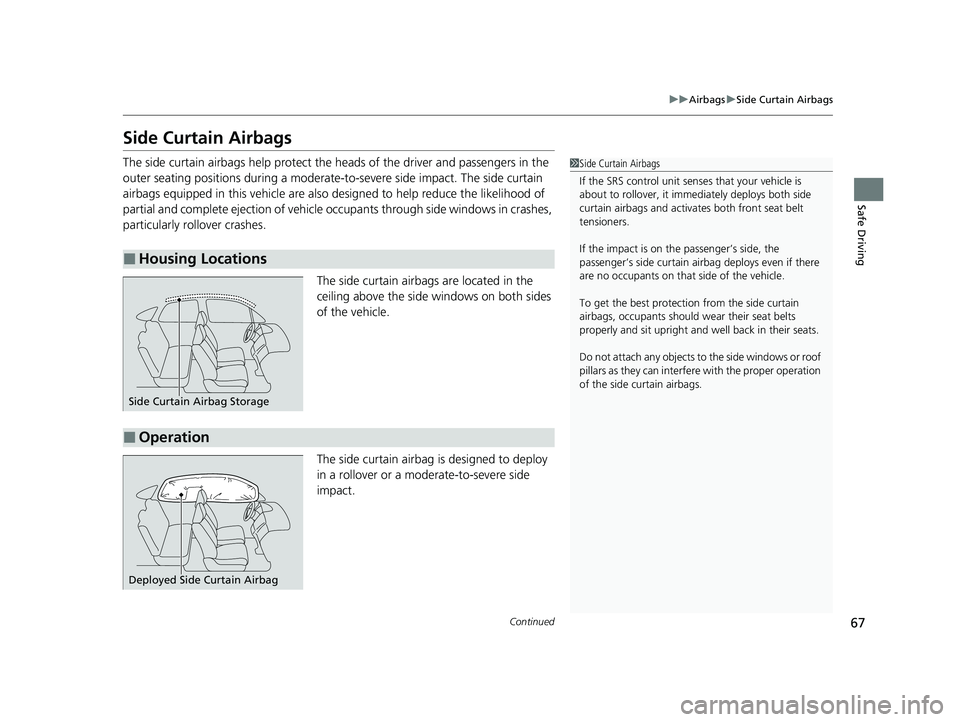
67
uuAirbags uSide Curtain Airbags
Continued
Safe Driving
Side Curtain Airbags
The side curtain airbags help protect the heads of the driver and passengers in the
outer seating positions during a moderate-to -severe side impact. The side curtain
airbags equipped in this vehicle are also de signed to help reduce the likelihood of
partial and complete ejection of vehicle occupants through side windows in crashes,
particularly rollover crashes.
The side curtain airbags are located in the
ceiling above the side windows on both sides
of the vehicle.
The side curtain airbag is designed to deploy
in a rollover or a moderate-to-severe side
impact.
■Housing Locations
1 Side Curtain Airbags
If the SRS control unit sens es that your vehicle is
about to rollover, it imme diately deploys both side
curtain airbags and activates both front seat belt
tensioners.
If the impact is on the passenger’s side, the
passenger’s side curtain airbag deploys even if there
are no occupants on that side of the vehicle.
To get the best protecti on from the side curtain
airbags, occupants should wear their seat belts
properly and sit upr ight and well back in their seats.
Do not attach any objects to the side windows or roof
pillars as they can interfere with the proper operation
of the side curtain airbags.
Side Curtain Airbag Storage
■Operation
Deployed Side Curtain Airbag
21 CLARITY FCV CSS-31TRT6400_02.book 67 ページ 2020年9月25日 金曜日 午後3時15分
Page 75 of 555
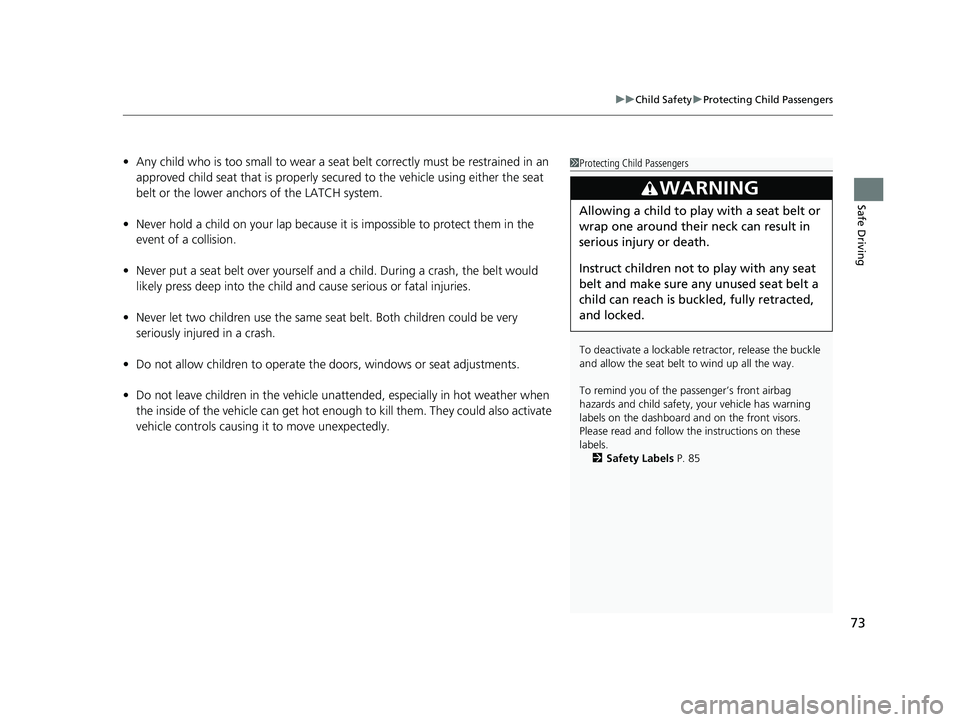
73
uuChild Safety uProtecting Child Passengers
Safe Driving
• Any child who is too small to wear a seat belt correctly must be restrained in an
approved child seat that is properly secu red to the vehicle using either the seat
belt or the lower anchors of the LATCH system.
• Never hold a child on your lap because it is impossible to protect them in the
event of a collision.
• Never put a seat belt over yourself and a child. During a crash, the belt would
likely press deep into the child and cause serious or fatal injuries.
• Never let two children use the same seat belt. Both children could be very
seriously injured in a crash.
• Do not allow children to operate the doors, windows or seat adjustments.
• Do not leave children in the vehicle unatte nded, especially in hot weather when
the inside of the vehicle can get hot enough to kill them. They could also activate
vehicle controls causing it to move unexpectedly.1 Protecting Child Passengers
To deactivate a lockable retractor, release the buckle
and allow the seat belt to wind up all the way.
To remind you of the pa ssenger’s front airbag
hazards and child safety, your vehicle has warning
labels on the dashboard and on the front visors.
Please read and follow the instructions on these
labels.
2 Safety Labels P. 85
3WARNING
Allowing a child to play with a seat belt or
wrap one around their neck can result in
serious injury or death.
Instruct children not to play with any seat
belt and make sure any unused seat belt a
child can reach is buckled, fully retracted,
and locked.
21 CLARITY FCV CSS-31TRT6400_02.book 73 ページ 2020年9月25日 金曜日 午後3時15分
Page 135 of 555
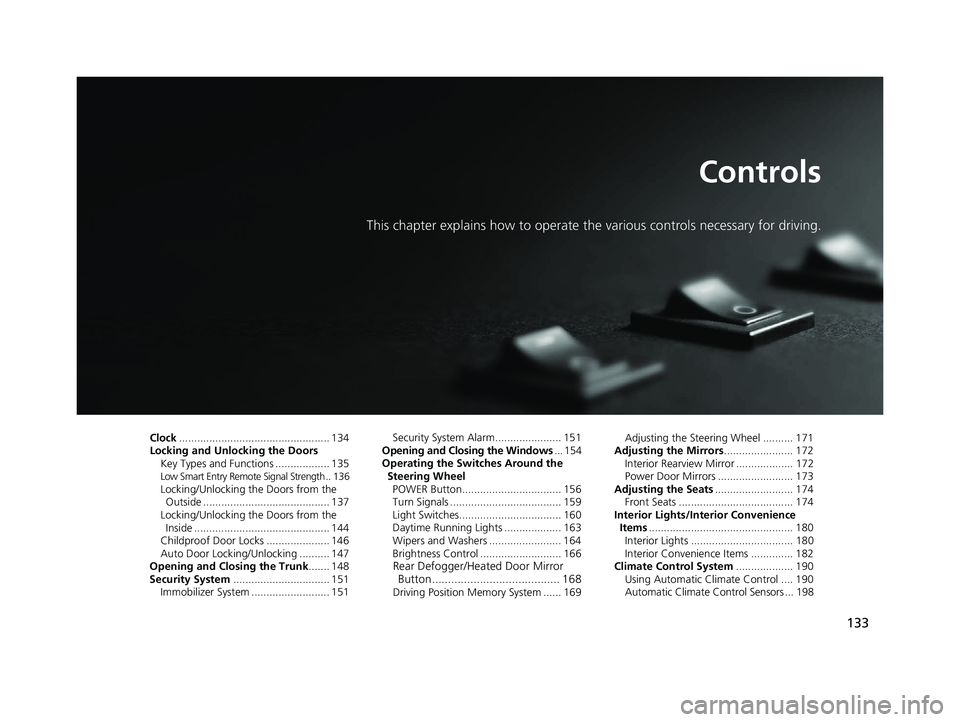
133
Controls
This chapter explains how to operate the various controls necessary for driving.
Clock.................................................. 134
Locking and Unlocking the Doors Key Types and Functions .................. 135
Low Smart Entry Remote Signal Strength .. 136Locking/Unlocking the Doors from the Outside .......................................... 137
Locking/Unlocking the Doors from the Inside ............................................. 144
Childproof Door Locks ..................... 146
Auto Door Locking/Unlocking .......... 147
Opening and Closing the Trunk ....... 148
Security System ................................ 151
Immobilizer System .......................... 151 Security System Alarm...................... 151
Opening and Closing the Windows ... 154
Operating the Switches Around the
Steering Wheel POWER Button................................. 156
Turn Signals ..................................... 159
Light Switches.................................. 160
Daytime Running Lights ................... 163
Wipers and Washers ........................ 164
Brightness Control ........................... 166
Rear Defogger/Heated Door Mirror Button........................................ 168
Driving Position Memory System ...... 169 Adjusting the Steering Wheel .......... 171
Adjusting the Mirrors ....................... 172
Interior Rearview Mirror ................... 172
Power Door Mirrors ......................... 173
Adjusting the Seats .......................... 174
Front Seats ...................................... 174
Interior Lights/Interior Convenience Items ................................................ 180
Interior Lights .................................. 180
Interior Convenience Items .............. 182
Climate Control System ................... 190
Using Automatic Climate Control .... 190
Automatic Climate Control Sensors ... 198
21 CLARITY FCV CSS-31TRT6400_02.book 133 ページ 2020年9月25日 金曜日 午 後3時15分